How to check copied content online for your website?
Are you looking for a way to find and remove stolen content from your WordPress website?
You’ve worked hard on your website, but your content is being stolen, published, and taking traffic away from your brand.
In this article from the Ded9, we will show you how to find and remove stolen content in WordPress, no matter if a single post or your entire site has been copied.
How and why is website content stolen?
One of the common ways to steal content is to delete blog content. This is where content is taken from your site, usually via your RSS feed, and republished on another site.
Sometimes your content is copied and pasted directly onto another website, including formatting, images, videos, and more.
Other times, your content will be reposted with attribution and a link back to your website without your permission. Although this can help your SEO, you may want to keep your original content only on your site.
Usually, the primary motivation behind stealing content is to profit from your hard work.
Having your content stolen is a stressful experience that, unfortunately, many website owners go through.
Just know you are not alone, and this is a fixable problem.
1. Set up automatic content theft notifications
Sometimes your loyal visitors will alert you that your content has been stolen or that they have seen it elsewhere on the web.
Fortunately, you don’t have to wait for a helpful reader to let you know.
The Google Alerts tool is often used for brand notifications. You enter your website name and receive email notifications whenever you are mentioned online.
However, this same feature can warn you of content being used without your permission.
Go to Google Alerts. Next, enter your website name and URL or use part of your article.
For example, if you end each blog post with the same call to action, you can receive a notification whenever the post appears online.

After that, you select “Sources.” Select “Blogs” and “Web” from the drop-down list. Then click on “Create Alert.”
You will receive an email whenever your content appears on the web or your website is mentioned.
2. Manual search for stolen content
One of the ways to find copied content from a website is to search for stolen content manually.
The Copyscape tool is a plagiarism check tool that can also be used to find plagiarized content published elsewhere on the web.
All you have to do is go to Copyscape and enter your website address. You can also enter a page or post URL to see if one of your blog posts or pages on your site has been copied and stolen.
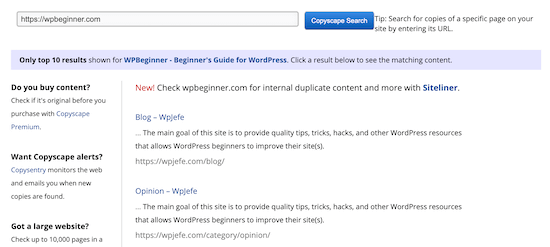
The free version of this tool gives you the top 10 results, which is enough for small WordPress blogs.
Upgrade to the premium version if you have a more extensive website or want to get results from every mention of your copied text.
The paid version of this tool allows you to scan up to 10,000 pages with one click. This can be very useful if you publish a lot of content on your WordPress website.
Another handy tool you can use is Grammarly. Grammarly is a popular online grammar-checking tool.
The premium version of Grammarly has a built-in plagiarism checker. You can copy and paste your content into the tool, and it will run a scan to see if there are any matches online.
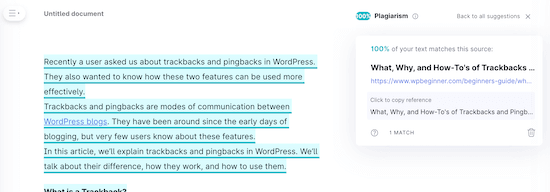
3. Contact the offending host or registrar
To report content copying, contact the hosting company used by the infringer.
So, you’ve found the stolen content; now what?
The easiest way to remove stolen content is to file a DMCA complaint against the website.
Usually, contact information can be challenging to find if it’s a scam website or a site that deletes your content from your RSS feed.
However, the IsItWP search tool can find where your domain and website are hosted.

Enter the domain that published your stolen content and click “Analyze Website.”
This tool collects any available information, including web hosting company and registrar.
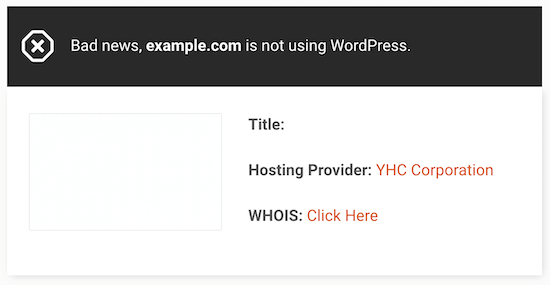
You will notice that the host and registrar are shown, even if the website is not using WordPress. You can contact the host and registrar directly to try to get the site removed.
Since content theft is illegal, web hosting companies do not want to host websites that violate the law.
Most reputable web hosting companies take DMCA requests seriously and will work with you to resolve the situation, including removing the infringing pages.
4. Submit a takedown notice to Google
Another way to learn how to find copied content from a website is to submit a form and file a DMCA complaint to Google.
Another way to remove stolen content is to contact Google directly.
It would help if you were careful using this method as it requires a lot of proof, and making false reports can get your account in trouble.
There are a few different ways to file a DMCA complaint with Google, but we recommend using one of the ways in the Google Search Console.
First, you need to link your site to Google Search Console. Then, you can use the DMCA complaint filing tool with Google.
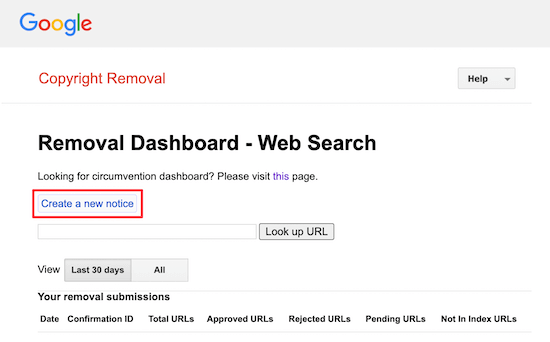
Click on “Create a new notice.”
This will bring up a page where you can enter all relevant information, including your contact information, the stolen posts, and the location of the stolen content.

The more detailed information you can provide, the more likely the offending site will be removed.
You can use a tool like the Wayback Machine to gather more information for your complaint.
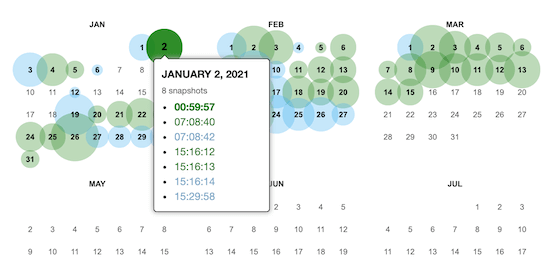
This tool takes snapshots of your website at different points in time.
Therefore, you can compare the article’s publication date with the offending site that later stole your content.
5. Use the All One Scanner and Takedown tool
You can also use the Digital Millennium Copyright Act (DMCA) tool to help find duplicate content around the web.
Just enter your URL into the tool to search for websites that have stolen your content.
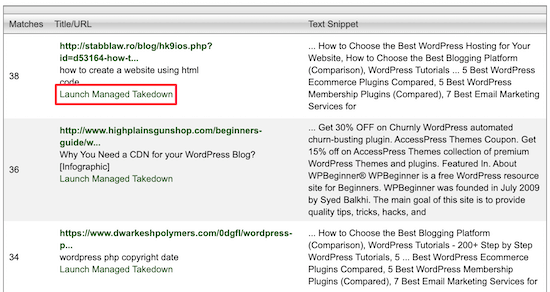
Once you find a site that has stolen or copied your content, click “Launch Managed Takedown” to start the takedown process.
Note that the results will not always be plagiarized content. Sometimes it can be infographics, backlinks, unlinked branding, and more.
The discovery and removal process is similar to the tools above, but instead of using multiple devices, you can take care of everything in one place.
Conclusion on dealing with content theft
Content theft is a real problem that every website owner struggles with. Unfortunately, the bigger your website gets, the more people will copy you.
Some outright steal content using automated content scraping tools, while others take inspiration from your content and translation.
As a website owner, having your content stolen is very frustrating. We deal with this regularly at Ded9, but automated bot sites are easy enough to get taken down with DMCA complaints.
However, since we are one of the largest virtual training sites, many other WordPress bloggers, theme companies, and even some hosting companies routinely copy our titles verbatim. They may translate the content to make it unique, but we know that our articles inspire it.
We take this imitation as a form of flattery further confirming that we are continuing on the right path.
If you have a competitor who copies your ideas all the time, but it’s not blatant copying, then there’s not much you can do about it. Don’t let it get you down, but stay focused on your mission to serve your audience.











